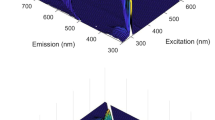Abstract
In vivo fluorescence methods are efficient tools for studying the distribution of phytoplankton in nature. Different algae species usually have different pigments with different ratios, which results in different fluorescence emission spectra. Based on multiple excitation wavelength fluorescence emission spectra, a discrimination technique is established in this study. The discrimination method, established by multivariate linear regression and weighted least-squares, was used to differentiate the samples cultured in the laboratory and collected from Jiaozhou Bay near Qingdao at the division level. The correctly discriminated samples were ≥ 86% for single algae samples, ≥ 88% for simulatively mixed ones, ≥ 91% for physically mixed ones and 100% for samples collected from Jiaozhou Bay. The result in this research is more definite for the physically mixed samples in the laboratory. The method described here can be employed to monitor the phytoplankton population in the marine environment.
Similar content being viewed by others
References
Beutler, M., Wiltshire, K. H., Meyer, B., Moldaenke, C., Lüring, C., Meyerhöfer, M., et al., 2002. A fluorometric method for the differentiation of algael populations in vivo and in situ. Photosyn. Res., 72: 39–53.
Chiao, P., Fessler, J. A., Zasadny, K. R., and Wahl, R. L., 1995. Spectral analysis using regularized non-negative least-squaresestimation [positron emission tomography]. Nucl. Sci. Symp. Med. Imaging Conf. Rec., IEEE 3: 1680–1683.
Gibb, S. W., Cummings, D. G., Irgoien, X., Barlow, R. G., and Mantoura, R. F. C., 2001. Phytoplnakton pigment chemotaxonomy of the Northeastern Atlantic. Deep-Sea Res. II, 48: 795–823.
Guillard, R. R. L., and Ryther, J. H., 1962. Studies of marine plankton diatoms. I. Cyclotella nand Hustedt and Detonula confervacea (Cleve) Gran. Can. J. Microbiol., 8: 229–239.
Holm-Hansen, O., Lorenzen C. J., Holmes R. W., and Strickland J. D., 1965. Fluorometric determination of chlorophyll. J. Cons. Perm. Int. Explor. Mer., 30: 3–15.
Hu, X. P., Su, R. G., Zhang, C. S., and Wang, X. L., 2008. Fluorescence discrimination technology for the red tide algae by spectra similarity index. Chin. J. Lasers, 35(1): 115–119.
Ikeya, T., Ohki, K., Takahashi, M., and Fujita, Y., 1994. Photosynthetic characteristics of marine Synechococcus spp. With special reference to light environments near the bottom of the euphotic zone of the open ocean. Mar. Biol., 118: 215–221.
Katty, W., Ilan, V., and Michael, G., 2002. Comparing similar spectra: from similarity index to spectral contrast angle. J. Am. Soc. Mass Spectr., 13: 85–88.
Keller, D., Selvin, C., Claus, W., and Guillard, L., 1987. Media for the culture of oceanic ultraphytoplankton. J. Phycol., 23: 633–638.
Lee, T., Tsuzuki, M., Takeuchi, T., Yokoyama, K. and Karube, I., 1995. Quantitative determination of cyanobacteria in mixed phytoplankton assemblages by an in vivo fluorimetric method, Anal. Chim. Acta, 302: 81–87.
Llewellyn, A., and Gibb, S. W., 2000. Intra-class variability in the carbon, pigment and biomineral content of prymnesiophytes and diatoms. Mar. Ecol. Prog. Ser., 193: 33–44.
Moberg, L., Karlberg, B., Blomquist, S., and Larsson, U., 2000. Comparison between a new application of multivariate regression and current spectroscopy methods for the determination of chlorophylls and their corresponding pheopigments. Anal. Chim. Acta, 411: 137–143.
Seppälä, J., 2003. Spectral absorption and fluorescence characteristics of the Baltic Sea phytoplankton. ICES CM 2003, L: 01.
Seppälä, J. and Balode, M., 1998. The use of spectral fluorescence methods to detect changes in the phytoplankton community. Hydrobiologia, 363: 207–217.
Stauber, L. and Jeffery, W., 1988. Photosynthetic pigments in 51 species of marine diatoms. J. Phycol., 24: 158–172.
Wright, S. W. and Jeffery, S. W., 1987. Fucoxanthin pigment markers of marine phytoplankton analysed by HPLC and HPTLC. Mar. Ecol. Prog. Ser., 38: 259–266.
Zapata, M., Jeffrey, S. W., Wright, S. W., Rodríguez, F., Garrido, J. L., and Clementson, L., 2004. Photosynthetic pigments in 37 species (65 strains) of Haptophyta: implications for ceanography and chemotaxonomy. Mar. Ecol. Prog. Ser., 270: 83–102.
Author information
Authors and Affiliations
Corresponding author
Rights and permissions
About this article
Cite this article
Hu, X., Su, R., Zhang, F. et al. Multiple excitation wavelength fluorescence emission spectra technique for discrimination of phytoplankton. J. Ocean Univ. China 9, 16–24 (2010). https://doi.org/10.1007/s11802-010-0016-x
Received:
Revised:
Accepted:
Published:
Issue Date:
DOI: https://doi.org/10.1007/s11802-010-0016-x




